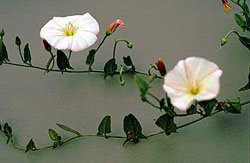Field bindweed identification and control
Convolvulus arvensis

Field bindweed is a perennial herbaceous plant with creeping and twining stems that grow along the ground and up through other plants and structures. It has an extensive system of rhizomes that can grow deep into the soil. Flowers are bell or funnel-shaped, white to pinkish and approximately 1 inch in diameter. They have 2 small bracts located 1 inch below the flower. Leaves are alternate, more or less arrowhead-shaped and have pointed or blunt lobes at the base. Stems are perennial and deciduous, growing along the ground and twining around and through other plants, to around 6.5 feet in length. It can be confused with another very invasive plant hedge bindweed (Calystegia sepium), which has larger flowers with two large leafy bracts right below the flowers and larger leaves. Field bindweed can grow in a wide range of conditions from full sun to full shade and is drought-tolerant. It is found in fields, turf, farmland, and residential areas. It reproduces via roots, rhizomes, and stem fragments, as well as by seeds that persist in soil 20 years or more. It be extremely difficult to eradicate once it is established due to very deep, extensive rhizomes and long-lived seed bank. It is a Class C noxious weed that is not selected for required control in King County. It is widespread in King County. Dense plantings of sod or shade-producing crops can reduce bindweed problems because it is not very competitive under shady conditions.
Also wanted
Hedge bindweed (Convolvulus sepium or Calystegia sepium) (a.k.a. "morning glory") looks and acts much like field bindweed, but its leaves and flowers are larger. The leaves are also hairless and more arrow-shaped. It is much more common in urban natural areas and backyard gardens. This species is not on the Washington State Weed List, but it is on the King County Weeds of Concern List due to its invasiveness. For photos and distribution information for hedge bindweed, please see the UW Burke Museum website.
Additional information on field bindweed
- Washington State Noxious Weed Control Board (external link)
- Bindweed weed alert (Acrobat file)
- Colorado Department of Agriculture (external link)
- University of California IPM (external link)
- North Dakota State University Extension (external link)
What to do if you find this plant in King County, Washington
Because field bindweed is so widespread, property owners in King County are not required to control it and we are not generally tracking infestations. We can provide advice on how to control field bindweed, but there is generally no legal requirement to do so.
Related information
Related agencies
Program offices are located at 201 S. Jackson St., Suite 600, Seattle, WA 98104. To contact staff, see the Noxious Weed Control Program Directory, send an email, or call 206-477-WEED (206-477-9333).

 Translate
Translate